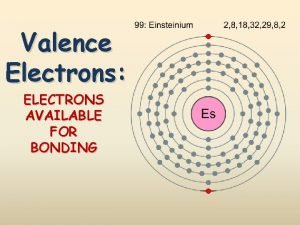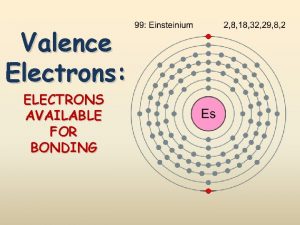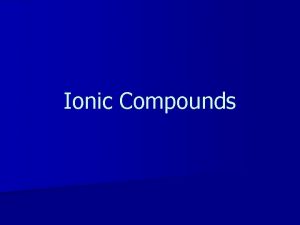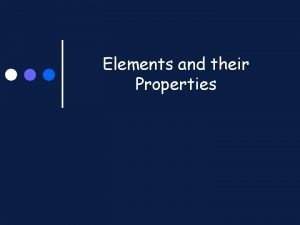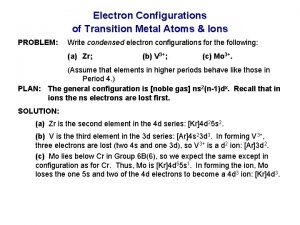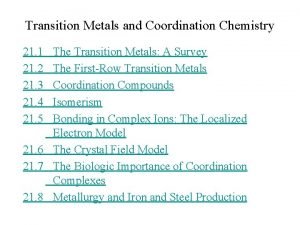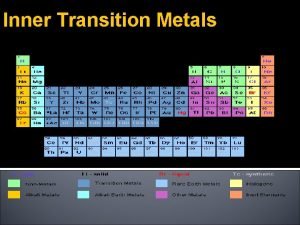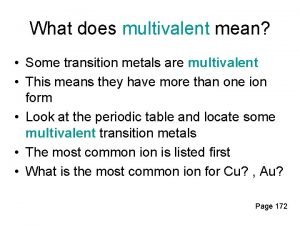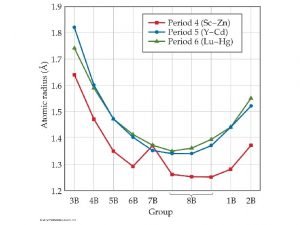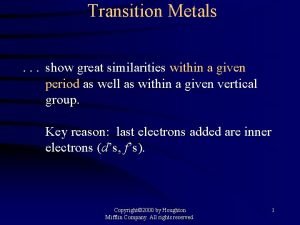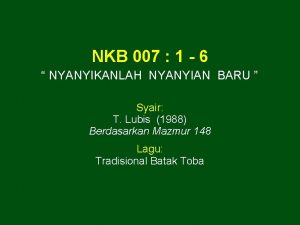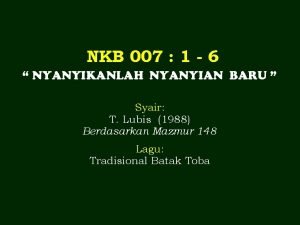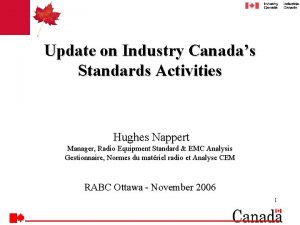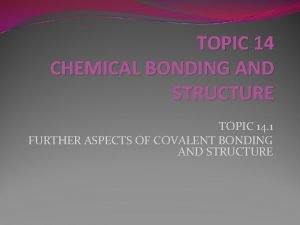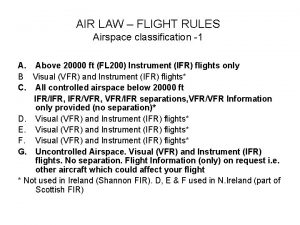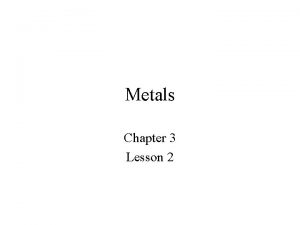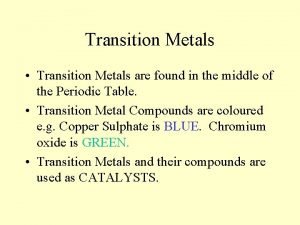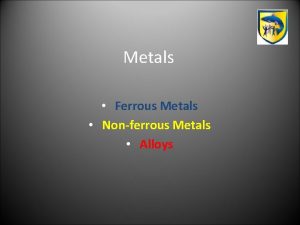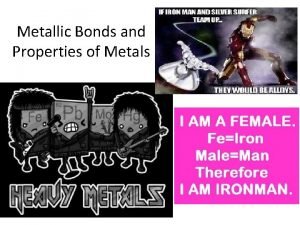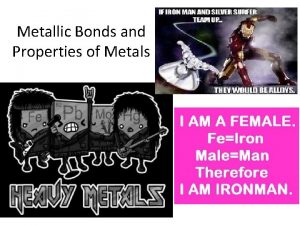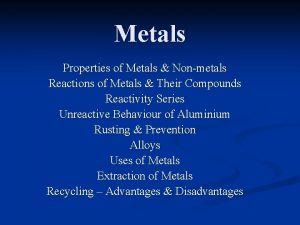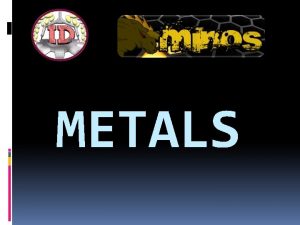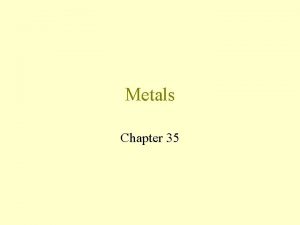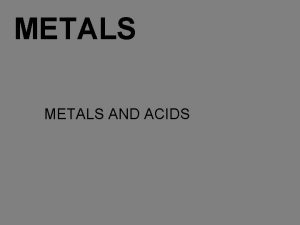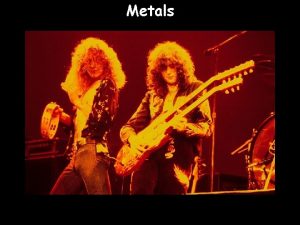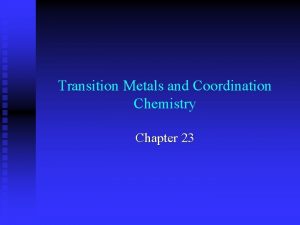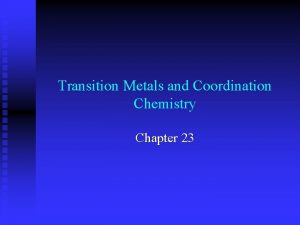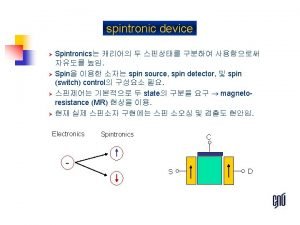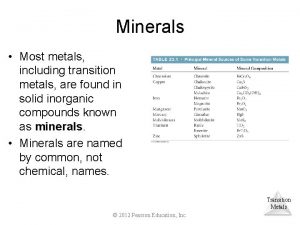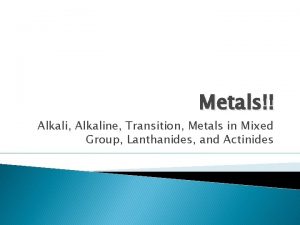Chemistry A level topic 007 Transition metals Lesson

















![In water – pretty much all transition metals form hexaaqua ions [M(H 2 O)6] In water – pretty much all transition metals form hexaaqua ions [M(H 2 O)6]](https://slidetodoc.com/presentation_image/4231e4b2af2fb6fb22992cacecdff01c/image-18.jpg)


![COMPLEX FORMATION Bidentate ligands – form two co-ordinate bonds 1, 2 -diaminoethane (en) [Cr(en)3]3+ COMPLEX FORMATION Bidentate ligands – form two co-ordinate bonds 1, 2 -diaminoethane (en) [Cr(en)3]3+](https://slidetodoc.com/presentation_image/4231e4b2af2fb6fb22992cacecdff01c/image-21.jpg)




![SHAPES OF COMPLEX IONS Geometric Isomerism cis e. g. [Pt. Cl 2(NH 3)2] trans SHAPES OF COMPLEX IONS Geometric Isomerism cis e. g. [Pt. Cl 2(NH 3)2] trans](https://slidetodoc.com/presentation_image/4231e4b2af2fb6fb22992cacecdff01c/image-26.jpg)
![SHAPES OF COMPLEX IONS Geometric isomerism e. g. [Co. Cl 2(NH 3)4]+ SHAPES OF COMPLEX IONS Geometric isomerism e. g. [Co. Cl 2(NH 3)4]+](https://slidetodoc.com/presentation_image/4231e4b2af2fb6fb22992cacecdff01c/image-27.jpg)
![SHAPES OF COMPLEX IONS Optical Isomerism e. g. [Co(en)3]3+ SHAPES OF COMPLEX IONS Optical Isomerism e. g. [Co(en)3]3+](https://slidetodoc.com/presentation_image/4231e4b2af2fb6fb22992cacecdff01c/image-28.jpg)

![What about…. Co(H 2 NCH 2 NH 2)2 Cl 2]3+ What about…. Co(H 2 NCH 2 NH 2)2 Cl 2]3+](https://slidetodoc.com/presentation_image/4231e4b2af2fb6fb22992cacecdff01c/image-30.jpg)




- Slides: 34

Chemistry A level topic 007 Transition metals Lesson 04 of 08: complex ion shapes

Main topic: Transition metals Sub-topic: Complex ions shapes Paper 1 and 3

Starter • Give the 4 key properties of transition metals • Name the two d block metals in period 4 which are not transition metals • Define a ligand • Give the co-ordination number of the complex pictured below: Iron III triacetate ion [Fe(C 2 O 4)3] 3 -

PROPERTIES OF TRANSITION METALS? 2) They form complexes (ligands form co-ordinate bonds to the metal ion). [Cu(H 2 O)6]2+ [Cu. Cl 4]2 - © www. chemsheets. co. uk A 2 043 20 -Jul-12

COMPLEX FORMATION Ligand atom / ion with a lone pair that forms coordinate bond to metal Complex metal ion with ligands co-ordinately bonded to it Co-ordination number of co-ordinate bonds from ligand(s) number to metal ions Lewis base Lewis acid lone pair donor (ligands are Lewis bases) lone pair acceptor Don’t need these definitions yet © www. chemsheets. co. uk A 2 043 20 -Jul-12

SHAPES OF COMPLEX IONS Co-ordination number 2 4 4 6 linear tetrahedral square planar octahedral 180º 109½º 90º Shape Bond angles Occurrence e. g. © www. chemsheets. co. uk A 2 043 20 -Jul-12

SHAPES OF COMPLEX IONS Co-ordination number 2 4 4 6 linear tetrahedral square planar octahedral Bond angles 180º 109½º 90º Occurrence Ag+ complexes e. g. [Ag(NH 3)2]+ Shape © www. chemsheets. co. uk A 2 043 20 -Jul-12

SHAPES OF COMPLEX IONS Co-ordination number 2 4 4 6 linear tetrahedral square planar octahedral Bond angles 180º 109½º 90º Occurrence Ag+ complexes Large ligands (e. g. Cl-) e. g. [Ag(NH 3)2]+ [Cu. Cl 4]2 - Shape © www. chemsheets. co. uk A 2 043 20 -Jul-12

SHAPES OF COMPLEX IONS Co-ordination number 2 4 4 6 linear tetrahedral square planar octahedral Bond angles 180º 109½º 90º Occurrence Ag+ complexes Large ligands (e. g. Cl-) Pt 2+ complexes e. g. [Ag(NH 3)2]+ [Cu. Cl 4]2 - [Pt. Cl 4]2 - Shape © www. chemsheets. co. uk A 2 043 20 -Jul-12

SHAPES OF COMPLEX IONS Co-ordination number 2 4 4 6 linear tetrahedral square planar octahedral Bond angles 180º 109½º 90º Occurrence Ag+ complexes Large ligands (e. g. Cl-) Pt 2+ complexes Commonest e. g. [Ag(NH 3)2]+ [Cu. Cl 4]2 - [Pt. Cl 4]2 - [Cu(H 2 O)6]2+ Shape © www. chemsheets. co. uk A 2 043 20 -Jul-12

SHAPES OF COMPLEX IONS

SHAPES OF COMPLEX IONS For each of the following complexes: • • • Draw the complex. Name the shape. Show bond angles. Give the metal oxidation state. Give the co-ordination number. 1) [Ag(CN)2]- 4) [Co(en)2 Cl 2 ]+ 2) [Cr(NH 3)6]3+ 5) [Pt(NH 3)2 Cl 2] 3) [Ni(en)3]2+ 6) [Fe(C 2 O 4)3]4© www. chemsheets. co. uk A 2 043 20 -Jul-12

SHAPES OF COMPLEX IONS 1 Linear 180º Ag +1 Co-ordination number = 2 2 Octahedral 90º Cr +3 Co-ordination number = 6 © www. chemsheets. co. uk A 2 043 20 -Jul-12

SHAPES OF COMPLEX IONS 2+ 3 Ni Octahedral 90º Ni +2 Co-ordination number = 6 4 Octahedral 90º Co +3 Co-ordination number = 6 © www. chemsheets. co. uk A 2 043 20 -Jul-12

SHAPES OF COMPLEX IONS Tetrahedral 90º Pt +2 5 Co-ordination number = 4 6 4 Fe Octahedral 90º Fe +2 Co-ordination number = 6 © www. chemsheets. co. uk A 2 043 20 -Jul-12

COMPLEX FORMATION Small ligands – can fit 6 of them round a transition metal ion e. g. H 2 O: , : OH-, : NH 3, : CN- [Cu(H 2 O)6]2+ © www. chemsheets. co. uk A 2 043 20 -Jul-12

COMPLEX FORMATION Small ligands – can fit 6 of them round a transition metal ion e. g. H 2 O: , : OH-, : NH 3, : CN- [Cu(H 2 O)6]2+ © www. chemsheets. co. uk A 2 043 20 -Jul-12
![In water pretty much all transition metals form hexaaqua ions MH 2 O6 In water – pretty much all transition metals form hexaaqua ions [M(H 2 O)6]](https://slidetodoc.com/presentation_image/4231e4b2af2fb6fb22992cacecdff01c/image-18.jpg)
In water – pretty much all transition metals form hexaaqua ions [M(H 2 O)6] z+ In this case [Co(H 2 O)6] 2+

Drawing complexes Tips • Show arrow • Show lone pairs • Don’t worry too much about the 3 D indicators • Show overall charge OR charges on individual ligands and central ion • Name the shape if asked for e. g. tetrahedral • Give formula if asked for • Give bond angle if asked for e. g. 109. 5 O

COMPLEX FORMATION Unidentate ligands – form one co-ordinate bond e. g. H 2 O: , : OH-, : NH 3, : CN-, : Cl- [Cu(H 2 O)6]2+ [Cu. Cl 4]2 - © www. chemsheets. co. uk A 2 043 20 -Jul-12
![COMPLEX FORMATION Bidentate ligands form two coordinate bonds 1 2 diaminoethane en Cren33 COMPLEX FORMATION Bidentate ligands – form two co-ordinate bonds 1, 2 -diaminoethane (en) [Cr(en)3]3+](https://slidetodoc.com/presentation_image/4231e4b2af2fb6fb22992cacecdff01c/image-21.jpg)
COMPLEX FORMATION Bidentate ligands – form two co-ordinate bonds 1, 2 -diaminoethane (en) [Cr(en)3]3+ ethanedioate (C 2 O 42 -) [Cr(C 2 O 4)3]3 - © www. chemsheets. co. uk A 2 043 20 -Jul-12

COMPLEX FORMATION Multidentate ligands – form several co-ordinate bonds EDTA 4 - e. g. [Cu(EDTA)]2 -

CIS-TRANS isomerism in octahedral complexes Which is which?

CIS-TRANS isomerism in square planar complexes

The one you need to know…. Used to treat cancer
![SHAPES OF COMPLEX IONS Geometric Isomerism cis e g Pt Cl 2NH 32 trans SHAPES OF COMPLEX IONS Geometric Isomerism cis e. g. [Pt. Cl 2(NH 3)2] trans](https://slidetodoc.com/presentation_image/4231e4b2af2fb6fb22992cacecdff01c/image-26.jpg)
SHAPES OF COMPLEX IONS Geometric Isomerism cis e. g. [Pt. Cl 2(NH 3)2] trans
![SHAPES OF COMPLEX IONS Geometric isomerism e g Co Cl 2NH 34 SHAPES OF COMPLEX IONS Geometric isomerism e. g. [Co. Cl 2(NH 3)4]+](https://slidetodoc.com/presentation_image/4231e4b2af2fb6fb22992cacecdff01c/image-27.jpg)
SHAPES OF COMPLEX IONS Geometric isomerism e. g. [Co. Cl 2(NH 3)4]+
![SHAPES OF COMPLEX IONS Optical Isomerism e g Coen33 SHAPES OF COMPLEX IONS Optical Isomerism e. g. [Co(en)3]3+](https://slidetodoc.com/presentation_image/4231e4b2af2fb6fb22992cacecdff01c/image-28.jpg)
SHAPES OF COMPLEX IONS Optical Isomerism e. g. [Co(en)3]3+

SHAPES OF COMPLEX IONS Optical Isomerism Key point : non-superimposable forms © www. chemsheets. co. uk A 2 043 20 -Jul-12
![What about CoH 2 NCH 2 NH 22 Cl 23 What about…. Co(H 2 NCH 2 NH 2)2 Cl 2]3+](https://slidetodoc.com/presentation_image/4231e4b2af2fb6fb22992cacecdff01c/image-30.jpg)
What about…. Co(H 2 NCH 2 NH 2)2 Cl 2]3+

Optical isomerism in octahedral complexes

Knowledge check… Can you define/explain cis-trans isomerism in transition metal complexes? CIS-TRANS Isomers are complexes that have the same molecular formula, but have a different arrangement of the ligands in space Can you define/explain optical isomerism in transition metal complexes? Optical Isomers are complexes that have the same molecular formula, but rotate plane polarise light in opposite directions as their 3 D arrangements are no-superimposable.

Complex in Tollen’s reagent (ammonical Silver Nitrate)

 Metals metalloids and nonmetals periodic table
Metals metalloids and nonmetals periodic table Examples of alloy metals
Examples of alloy metals Compare metals nonmetals and metalloids
Compare metals nonmetals and metalloids Grade 4 natural science matter and materials
Grade 4 natural science matter and materials Natural science grade 7 term 2 matter and materials
Natural science grade 7 term 2 matter and materials Examples of non metal
Examples of non metal Valence electrons for transition metals
Valence electrons for transition metals Transition metals valence electrons
Transition metals valence electrons The octet rule states that
The octet rule states that Inner transition metals
Inner transition metals Transition metal atoms
Transition metal atoms A linear complex ion with ligands on the x-axis
A linear complex ion with ligands on the x-axis Inner transition metals definition
Inner transition metals definition List of multivalent metals
List of multivalent metals Ionization energy of transition elements
Ionization energy of transition elements Ionic compounds containing transition metals
Ionic compounds containing transition metals Knockhardy chemistry
Knockhardy chemistry Transition metals display great similarities
Transition metals display great similarities Syair t
Syair t Nkhb-007
Nkhb-007 Bandwidth ancoats
Bandwidth ancoats Kal 007
Kal 007 Coa circular 2003-007
Coa circular 2003-007 Ices-007
Ices-007 Okn 007
Okn 007 Transitional topic sentences
Transitional topic sentences Unity and coherence
Unity and coherence Narrowed down topic examples
Narrowed down topic examples Transition state diagram chemistry
Transition state diagram chemistry Topic 14 ib chemistry
Topic 14 ib chemistry Topic 11 organic chemistry
Topic 11 organic chemistry Enthalpy of combustion formula ib
Enthalpy of combustion formula ib Topic 2 chemistry
Topic 2 chemistry Transition level
Transition level Transition level vs altitude
Transition level vs altitude






